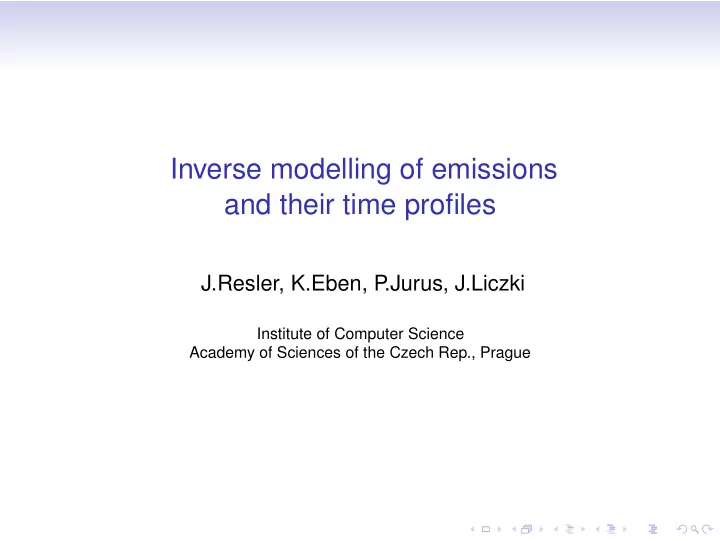

Inverse modelling of emissions and their time profiles J.Resler, K.Eben, P .Jurus, J.Liczki Institute of Computer Science Academy of Sciences of the Czech Rep., Prague
Introduction Data assimilation in meteorological models: • Improvement of the model IC -> forecast improvement. Data asimilation in CTM: • Improvement of the chemical IC -> small improvement of the forecast • Forcing by emission inputs and meteorological fields Meteorological models Ensemble of CTM states deterministic chaos converges to a common solution Our experience gathered with mesoscale CTM ∗ ) : Decrease of the ensemble spread during 24 hours: O 3 to 20%, NO 2 to 10% Conclusion: we need to improve the inputs and the model itself. ∗ ) K.Eben et al.: An ensemble Kalman filter for short term forecasting of tropospheric ozone concentrations, Q.J.R.Meteorol.Soc.(2005)
4DVar with the CMAQ model Pilot assimilation experiment with simplified design: • 4DVar based on the CMAQ adjoint model. • In-situ and satellite observations of NO 2 . • Optimization of IC and emissions of NO and NO 2 . • Corrections of emissions parametrized by one coefficient per gridcell. • Correction coefficients from one day used for the forecast of the next day (persistent statistical predictor). Conclusions: • Emission corrections quite stable from day to day. • Forecast improved for NO 2 but not for O 3 .
Enhanced assimilation design Enhancements in the assimilation method: • Optimization of diurnal emission profiles. • Implementation of the adjoint for SAPRC99 mechanism. • Observation of O 3 - stations and satellite columns are assimilated in addition to NO 2 • Optimization of more species. • Species with significant backward sensitivity. • Radicals and non-reactive species excluded.
Emission profiles optimization • To avoid an ill-posed problem, emission profile corrections were parameterized using a fixed basis of five splines. • Emission correction factor calculated as linear combination. • For every day the 4DVar gives estimates of the coefficients. Basis functions used for parametrization of the correction of diurnal emission profile.
Setup of the experiments Experiment with all proposed enhancements. Horizontal domains (left) and in-situ stations (right). Tropospheric NO 2 columns and O 3 profile layer at July 1 2008. GOME2 10:24 (left), OMI 13:24 (center), IASI 12:00 (right) Assimilation episode: June 28 - July 5, 2008.
Emission correction coefficients for the five basis functions Maps of the optimized emission coefficients for 30.6.2008 for differents parts of the day Upper from left: night, morning, lower from right: midday, evening, night. Assimilation shifts emissions from evening peak to morning in some regions.
Results - concentration in Brno Graph of the concentrations of NO 2 in Brno,CZ. Red: modelled, blue: optimized, green: forecasted, black: observerd (weighted average of background stations).
Results - correction factor and emission Graphs of the daily profile of the correction factor and emission of NO 2 in Prague,CZ for 2.7.2008. Black: emission modelled by emission model, red: corrected emission.
Results - correction factor and emission Graphs of the daily profile of the correction factor and emission of NO 2 in Brno,CZ for 2.7.2008. Black: emission modelled by emission model, red: corrected emission.
Results - correction factor and emission Graphs of the daily profile of the correction factor and emission of NO 2 in Usti nad Labem,CZ for 2.7.2008. Black: emission modelled by emission model, red: corrected emission.
Results - correction factor and emission Graphs of the daily profile of the correction factor and emission of NO 2 in Koln,DE for 2.7.2008. Black: emission modelled by emission model, red: corrected emission.
Results - performance of the method Improvement of the analysis and forecast of the NO 2 and O 3 NO 2 O 3 Analysis Forecast Analysis Forecast 28.6.2008 27,88 - 11,91 - 29.6.2008 39,41 27,59 16,37 0,26 30.6.2008 26,54 14,66 24,87 1,60 1.7.2008 22,02 17,26 21,39 7,83 2.7.2008 26,59 17,26 15,21 6,21 3.7.2008 26,04 18,95 18,16 6,07 4.7.2008 25,61 11,00 20,80 12,08 5.7.2008 - 20,84 - 9,70 Relative percentage improvement of analysis and forecast.
A detailed long-term study A long-term study of performance of the method is running at present. (4 months, spring and summer 2007). The aims of this study: • To verify the method in a long-term run. • Investigation of contributions of different kinds of observations and of the extent of their synergy. • Assessment of influence of different parametrizations of diurnal emission profiles. • To get statistical characteristics of emission correction.
Contributions of different kinds of observations to emission corrections Emission correction factors for NO for midday at Apr 8 2007 induced by ground level resp. satellite observations. NO 2 observations (upper left), O 3 observations (upper right) and tropospheric collumns of NO 2 from OMI and GOME-2 (down).
Emission profile parametrization Emission correction factor for Usti nad Labem for daily total correction (black), five b-splines parametrization (red) and independent correction of every hour (green). Weekly cycles of corrections!
Conclusions • The 4DVar method proves to be a powerful tool for optimization of emissions and their time profiles. • Forecast from optimized model corresponds better with observations. • Many issues still need to be resolved and a long-term validation has to be finalized. • The proposed method can serve a base for building data-driven emission models.
Thank you for your attention E-mail: resler@cs.cas.cz Acknowledgement: This work was supported by the Grant Agency of the Academy of Sciences of the Czech Rep. (grant No. 1ET400300414, framework „Information Society“), by the grant No. SP/1a4/107/07 of the Ministry of Environment of the Czech Rep. and by the Institutional research plan AV02 10300504 Computer Science for the Information Society “Models, Algorithms, Applications”.
Recommend
More recommend